
"Unidentified municipal incinerator No. 1, 1930s"
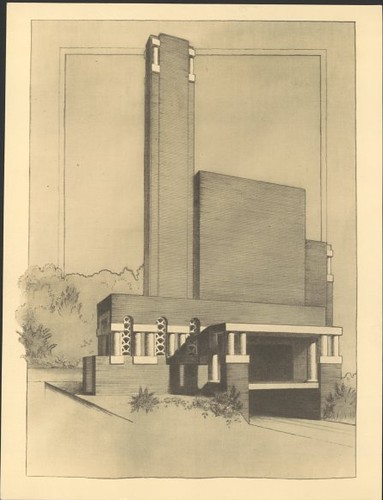
"Perspective view of incinerator, Thebarton, South Australia, ca. 1937"
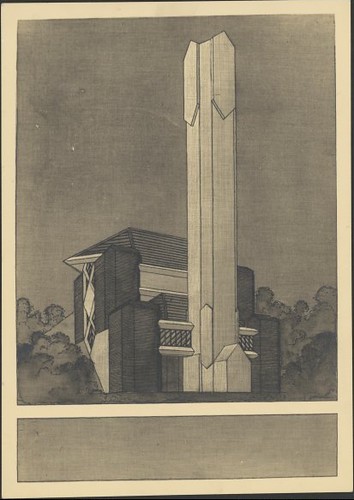
"Perspective view of Brunswick incinerator, Brunswick, Victoria 1934"
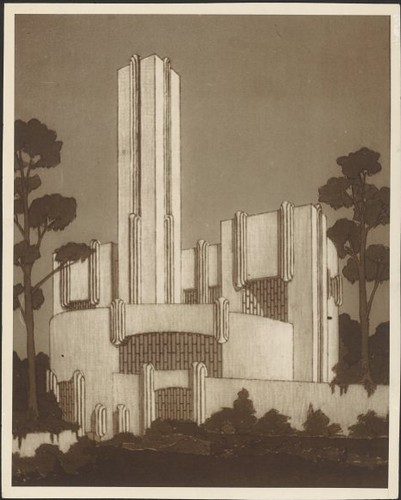
"Oblique perspective view of unidentified municipal incinerator, 1930s"
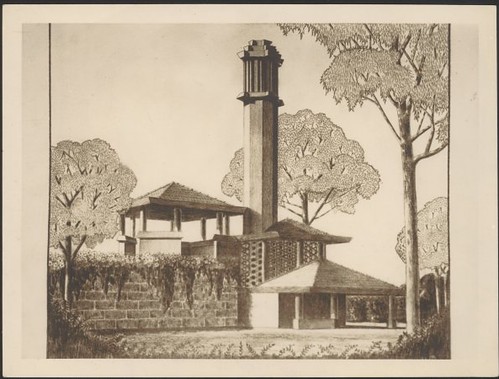
"Oblique perspective view of unidentified municipal incinerator, 1930s"
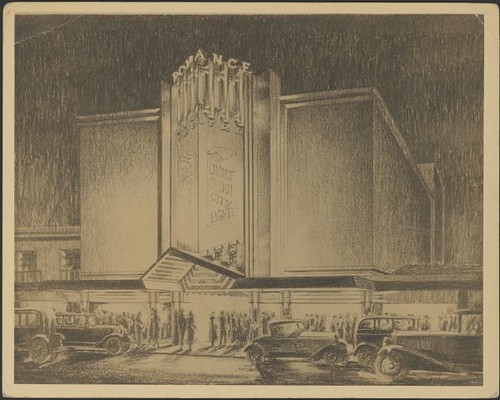
"Exterior facade perspective of Romance Theatre, Melbourne, Victoria 1931"
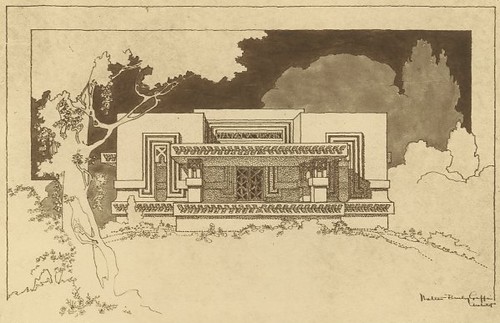
"Elevation of Jwala Bank, Jhansi, India 1936"
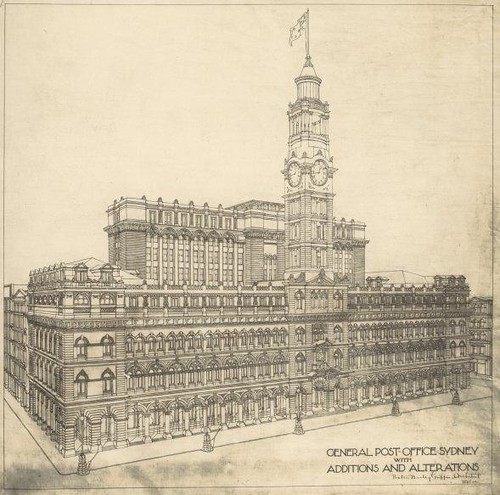
"Perspective of General Post Office, Sydney
showing proposed additions and alterations 1919"
showing proposed additions and alterations 1919"
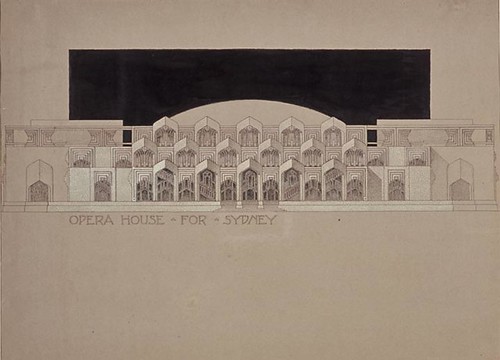
"Opera House for Sydney 1938"
Walter Burley Griffin (1876-1937) was a Chicago architect with a background in landscape design. He is closely associated with the Prairie School, a uniquely American style of architecture that favoured horizontal lines (reflecting prairies) and whose most famous practitioner was Frank Lloyd Wright.
Griffin worked under Wright for a few years at the beginning of the 20th century until they had a dispute over salary payments. Ultimately, this led to an irreconcilable estrangement, and it seems Wright was rather disparaging of Griffin's talents whenever he referred to him later on.
One of the benefits of the association with Wright (beyond the obvious professional influence) was that Griffin met his future wife, Marion Mahony, at the Wright office. She, too, was an architect and a particularly gifted draughtsman (draughtswoman?).
"In the 28 years of their architectural partnership, the Griffins designed over 350 building, landscape and urban-design projects as well as designing construction materials, interiors, furniture and other household items."Dare I suggest that their marriage was established on a strong foundation? It was while they were on their honeymoon that the Griffins learned of a competition to design the city of Canberra which would become the new capital city of Australia (1927). They "worked feverishly to prepare the plans" before the submission deadline.
Their proposal was of course the winning entry (1912) and gave the Griffins international recognition. Of the Canberra plan, Walter Burley Griffin remarked:
"I have planned a city that is not like any other in the world. I have planned it not in a way that I expected any government authorities in the world would accept. I have planned an ideal city - a city that meets my ideal of the city of the future."Whether or not a survey among Australians today would give such a favourable review of the outcome is perhaps a moot point. The circular alignments and satellite arrangements of the suburbs evoke an overtly artificial reality, but after visiting (and, significantly, not living in) Canberra many times over the last couple of decades, I've become comfortable with its atmosphere at least. And, as a government bureaucracy-heavy city, it's fairly well appointed with amenities like good quality transport and roads, as well as cultural establishments. It's also close to our snowfields which is a big plus! An eponymous lake, built in 1963 in the centre of Canberra, assures that anyone who visits the city is familiar with the name of Burley Griffin.
The Griffins moved to Australia soon after their Canberra design was selected and they stayed for the next twenty-odd years. Walter Burley Griffin died in Lucknow in India in 1937 following a two year stint working in the sub-continent.
I was particularly taken with the modernist/Art Deco building designs and I'm sure I've over emphasised - in the selection above - the prevalence of incinerator designs among his legacy. It would be a starving architect that tried to rely upon municipal incinerator designing for a decent living in today's world.
- The Australian National Library purchased the last private collection of Walter Burley Griffin material in recent years. The images above were selected from more than two thousand drawings, lithographs, photographs, transparencies, postcards and negatives that were digitised and uploaded late last year (The Eric Milton Nicholls Collection). [I think I must have searched on 'plan' or 'drawing' or the somesuch]
- The extensive Griffin Society site (Australia) has a large gallery of images.
- 'An Ideal City - the 1912 Competition to Design Canberra' is a great site. They have the top forty six short-listed designs from the competition - a kind of 'unrealised Canberra' - from which I would have appropriated some images if they weren't all posted within Zoomify constraints.
- 'Walter Burley Griffin - In His Own Right' - an extensive PBS site arising from a documentary made a decade ago.
- 'Prairie Styles - An Online Museum of Prairie Style Architecture' has a quick overview gallery of some houses in Illinois designed by Griffin (before leaving for Australia).
- The Walter Burley Griffin Society of America.
- Wikipedia: Walter Burley Griffin/Prairie School.
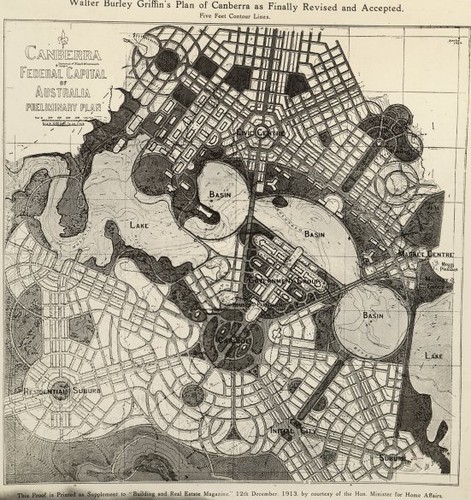



















19 comments :
His design for the Sydney Opera House is particularly interesting in comparison with the more recent building. Was this design built? Are there any perspective views available?
I'm fairly sure it wasn't built. You'll have to trawl through the image archives to find out if there are any other plans.
Oddly, that sketch is dated a year after Griffin's death. Perhaps that's when it was completed or catalogued? The design competition for which the well known Opera House was chosen didn't happen until much later. See this.
Lovely and informative as usual peacay. Stuff like this gets me where I live, so to speak, and sets my heart longing, I almost always get that reaction, too, when I visit your blog.
I must say I am much taken with the incinerators. It's true that Czech functionalist architects did a lot of crematoria around the same time, but I gather there was a big fashion for cremation in the 20s and 30s, whereas my knowledge of municipal incinerators is absolutely nil. It's hard to imagine municipal incineration having quite the same appeal for the average person as cremation (said she, having just returned from spading some cremated remains into a nice miniature-size unmarked grave).
The theater design, by contrast, ends up looking like any old Art Deco-ish movie house. Nice but nothing remarkable. I wonder if the incinerators are still in operation?
any old Art Deco-ish movie house
And therein lies its charm. I like them built or drawn.
This one is still alive. I think it might take some serious delving to work out which of the plans were actually realised. There are very few incinerators surviving methinks; that sort of approach to dealing with garbage etc having mostly fallen out of favour in the 70s. I wonder if hospitals still have them? I know my local one was appropriated at times for disposal of contraband.
having just returned from spading some cremated remains into a nice miniature-size unmarked grave
Please remain where you are. Officers from the Pittsburgh Police Dept. will be with you shortly.
I suppose the grave wasn't totally unmarked. We left some daffodils and the like.
No slight meant to Art Deco theaters. I was very excited when the one around the corner from my parents was renovated. (Photos of same are scattered around its site.) And I have been known to frequent the Paramount (Wikipedia entry here) and the Castro.
I'm planning to add some Walter Burley Griffin to the syllabi.
Oops. Sorry Karla. Milt -- I remember your posting about his passing. I had something totally different going on in my mind's eye.
And yeah, I'm quite a fan of art deco architecture (and other manifestations come to think of it) and it does evoke a Hollywoodesque and movie nostalgia feeling. Movie theatres and art deco are married for eternity, even if only (eventually) in history books.
There was a great episode of Compass (ABC), and an article in NEXUS, all about the esoteric & specifically anthroposophist influences in the Burley Griffins' designs, and the incinerators were among my favorites. More than merely waste disposal units, they were altar shaped portals where matter was transmuted into energy.
Thanks for posting these great images.
Thanks very much Richard. I see there's more to that Griffin comment -- "an ideal city" -- than meets the eye. The Compass transcript is online and here is Professor Proudfoot's "The Secret Life of Canberra" from 1994. There's also a Nexus abstract by Proudfoot and Grahama Pont from 2002: 'From Cosmic City to Esoteric Cinema: Pythagorean Mathematics and Design in Australia'. They all sit in the freemasonry rather than architecture shelves I suspect.
There is certainly something transformative and ethereal about those chimney stacks but I'm not so sure I'm persuaded to view Canberra as an element of a "civic religion". Perhaps I've been there too many times.
[I don't think I've ever heard the expression "jazz-age religions" (precursor of New Age phenomenon)]
I live about three blocks from 104th Place in Chicago, which has the honorary name of Walter Burley Griffin Place. Over a two block stretch, there are seven of his houses. Nothing as cool as these designs, but they are still pretty neat.
And the conversation continues at BB.
As a born and bred Canberra boy (who recently fled to London) I have a wistful longing for WBG's original designs, predominantly for the beauty and elegance but also for his long-term evolution of the city. The biggest problem with Canberra is that successive governments strayed from WBG's vision and, like most modern metropoleis, has succumbed to the double-edged sword of increasing populations and penny-pinching bureacrats. Admitedly, Canberra is a young city but any traces of WBG's art deco architecture were replaces by the Bauhaus concrete monstrosities of the 70's. Interstingly, I noticed a similar trend on a recent trip to Chicago, EBG's home town...
Tells you some of what was built and what wasn't:
http://www.griffinsociety.org/Lives_and_Works/a_melbourne.html
Thanks Marcus. Unfortunately the plans on display at NLA are often lacking in details: "unidentified municipal incinerator" doesn't quite do it.
There's a couple/few more incinerators via google images too.
Just like to tell you about the Ipswich Little Theatre building which is a converted Walter Burley Griffin Incinerator: http://www.ipswichlittletheatre.com.au/home.html
Revisiting this ever-fascinating topic, yes, I think I'm absolutely going to have to put at least one of these incinerators into the modernist architecture portion of Intro to Modern (along with a Czech functionalist crematorium or two... I've already got Janák's rondocubist crematorium in Pardubice inserted, thanks to a Wikipedia photo).
As for civic and jazz-age religion, well, I'm not sure what was fashionable, but a few years earlier there was certainly that proto-New-Age craze for theosophy and related spiritual paths. If there was an artist around 1910 who was not into theosophy, I'd like to know who it could have been (no, don't reveal that there were hordes, it would shock my tender sensibilities).
And I'll be sure to let you know next time I shovel ashes into an unmarked grave. You never know who I might be disposing of.
I like how they tack 'theoretician' to the list of accomplishments/c.v. of Janák. I think I'll have to add that to my own, much more pedestrian, list of skills.
Rondocubism eh? Sounds like an affection for a Caribbean cocktail or something. Found this Czech cubism image tour via 'A Charming Impasse: Czech Cubist Architecture' by Tomas Dvorak, in which it is noted:
"The period after the war is often referred to as "Rondocubism", or the "National style" as it was called at the time. Rondocubism is a specific Czech version of Art Deco, using motifs of folk architecture and national colors."
That rondocubist Crematorium at Pardubice is quite surreal, nearly cartoon-like. Me likey.
Enjoyed your posts on Griffin. The municipal incinerator in Holmes Road Moonee Ponds has been converted to a performing arts venue. But the gems of Griffins work in Melbourne include the remarkable Capitol Theatre (1924) - probably his only cinema design (where he reputedly neglected to include a bio=box in the design!) and Newman College at Melbourne University. Happy to send images to anyone who wants a look at them.
regards Robin Grow, President Art Deco & Modernism Society Melbourne.
How come Blogger forwarded Rob's comment to me and not its immediate predecessor...? Good thing Rob was prompting me to say that I did put Griffin's Australian incinerators in my lecture and that now that I've got more space to devote to Prairie School architecture (different course), I might throw in more Griffin.
As for Janák, I think we can definitely call him a theoretician, which is not something I'd say of every Czech modernist architect. Unfortunately not much of his writing is translated, and I haven't had cause yet to read it in Czech (which is probably just as well).
I've never heard Rondo-cubism called a variant of Art Deco, that I can think of. I suppose in its way it could be, but I think of it more as growing out of the interest in geometric and crystalline forms that was so evident in cubist architecture. (You like the Pardubice crematorium? apart from the color it's almost tame compared to some of the earlier cubist designs. Well, maybe.)
Post a Comment
Comments are all moderated so don't waste your time spamming: they will never show up.
If you include ANY links that aren't pertinent to the blog post or discussion they will be deleted and a rash will break out in your underwear.
Also: please play the ball and not the person.
Note: only a member of this blog may post a comment.